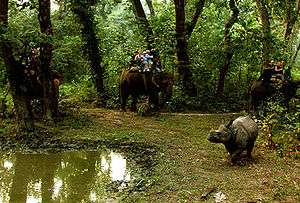Wildlife tourism


Wildlife tourism can be an eco and animal friendly tourism, usually showing animals in their natural habitat. Wildlife tourism, in its simplest sense, is watching wild animals in their natural habitat. Wildlife tourism is an important part of the tourism industries in many countries including many African and South American countries, Australia, India, Canada, Indonesia, Bangladesh, Malaysia, Sri Lanka and Maldives among many. It has experienced a dramatic and rapid growth in recent years worldwide and is closely aligned to eco-tourism and sustainable-tourism.
Wildlife tourism is also a multimillion-dollar industry offering customized tour packages and safaris.
Description
Wildlife tourism encompasses non-consumptive interactions with wildlife, such as observing and photographing animals in their natural habitats.[1] It has the recreational aspects of adventure travel, and supports the values of ecotourism and nature conservation programs.
Negative impacts
Wildlife tourism can cause significant disturbances to animals in their natural habitats. The growing interest in traveling to developing countries has created a boom in resort and hotel construction, particularly on rain forest and mangrove forest lands. Wildlife viewing can scare away animals, disrupt their feeding and nesting sites, or acclimate them to the presence of people. In Kenya, for example, wildlife-observer disruption drives cheetahs off their reserves, increasing the risk of inbreeding and further endangering the species.
Direct impacts
The effect that wildlife tourism will have on wildlife depends on the scale of tourist development and the behavior and resilience of wildlife to the presence of humans. When tourists activities occur during sensitive times of the life cycle (for example, during nesting season), and when they involve close approaches to wildlife for the purpose of identification or photography, the potential for disturbance is high. Not all species appear to be disturbed by tourists even within heavily visited areas.
Disturbing breeding patterns
The pressures of tourists searching out wildlife to photograph or hunt can adversely affect hunting and feeding patterns, and the breeding success of some species. Some may even have long-term implications for behavioral and ecological relationships. For example, an increase in boat traffic has disturbed the feeding of giant otters in Manú National Park, Peru. Further disturbance to wildlife occurs when tourist guides dig up turtle nests and chase swimming jaguars, tapirs, and otters to give clients better viewing opportunities. On the shores of Lake Kariba in Zimbabwe, the number of tourist boats and the noise generated has disrupted the feeding and drinking patterns of elephants and the black rhinoceros - it is feared that further increases in boat traffic will affect their reproductive success.
Disturbing feeding patterns
Artificial feeding of wildlife by tourists can have severe consequences for social behavior patterns. Artificial feeding by tourists caused a breakdown of the territorial breeding system of land iguanas on the South Plaza in the Galápagos Islands. Territories were abandoned in favor of sites where food could be begged from tourists, and this has had a negative effect on the breeding success of iguanas. Artificial feeding can also result in a complete loss of normal feeding behaviors. In the Galápagos Islands, overfeeding by tourists was so extreme that, when stopped, some animals were unable to locate their natural food sources. Similarly, until the early 1970s, the diet of some grizzly bears in Yellowstone National Park consisted, to a large extent, of food wastes left by visitors at park refuse sites. When these sites were closed, the bears showed significant decreases in body size, reproductive rate, and litter size.
Disruption of parent-offspring bonds
Wildlife tourism also causes disruption to intra-specific relationships. Attendance by female harp seals to their pups declined when tourists were present and those females remaining with their pups spent significantly less time nursing and more time watching the tourists. There is also a risk of the young not being recognized, and being more exposed to predator attacks. A similar concern has been expressed over whale watching, whale calves normally maintain constant body contact with their mothers but, when separated, can transfer their attachment to the side of the boat.
Increased vulnerability to predators and competitors
The viewing of certain species by wildlife tourists makes the species more vulnerable to predators. Evidence of this phenomenon has been recorded in birds, reptiles and mammals. Problems have occurred in breeding colonies of pelicans .
Positive impacts
Habitat restoration by eco-lodges and other tourism operations
Many owners of eco-accommodation or wildlife attractions preserve and restore native habitats on their properties
In a large way, the tourists and travellers visiting the wildlife destinations contribute to the conservation and improvement of the conditions for the animals.
The flow of the people keeps the poachers at bay from killing the valuable animals.
The local tribes have a decent living as the tourism flourishes as it provides opportunities of improved livelihood.
Conservation breeding
Many wildlife parks (e.g. David Fleay Wildlife Park, Gold Coast, Australia) and zoos breed rare and endangered species as a major part of their activities, and release the progeny when possible into suitable habitat.
Financial donations
Some wildlife tourism contributes monetary donations to conservation efforts e.g. Dreamworld, Gold Coast, has a display of Sumatran tigers, and money from visitor donations and from their 'tiger walk' goes to Sumatra to assist in-situ conservation of wild tigers.
Quality interpretation
A good wildlife guide will impart a deeper understanding of the local wildlife and its ecological needs, which may give visitors a more informed base on which to subsequently modify their behaviour (e.g. not throw out plastic bags that may be eaten by turtles) and decide what political moves to support.
Research and monitoring
Some wildlife tourism operations contribute to monitoring of wildlife numbers or general research relevant to conservation
Anti-poaching
Bringing tourists regularly into some areas may make it more difficult for poachers of large animals or those who collect smaller species for the black market
| Wikimedia Commons has media related to Wildlife tourism. |